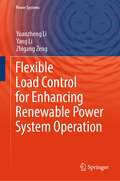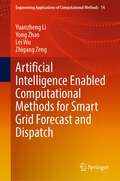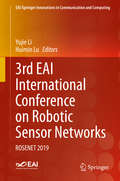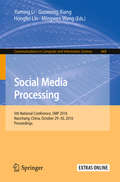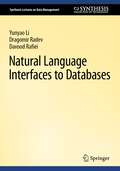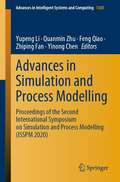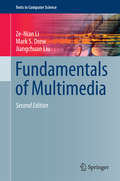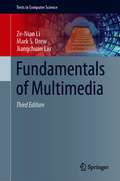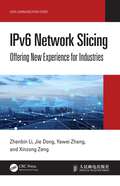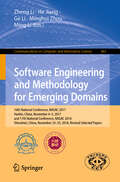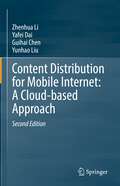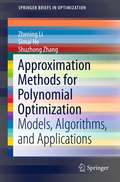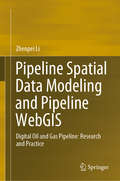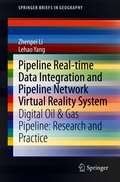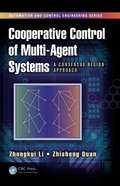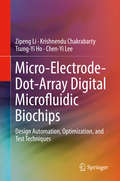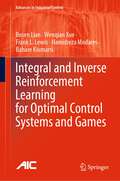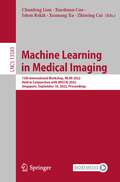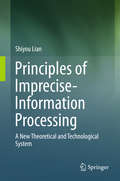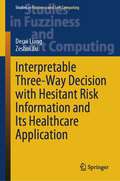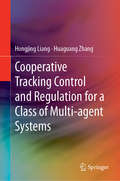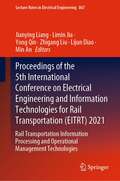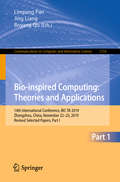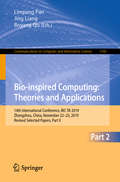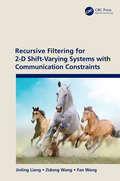- Table View
- List View
Flexible Load Control for Enhancing Renewable Power System Operation (Power Systems)
by Yuanzheng Li Yang Li Zhigang ZengThis book addresses the pressing challenges faced by renewable power system operation (RPSO) due to the increasing penetration of renewable energy and flexible load. These challenges can be divided into two categories. Firstly, the inherent uncertainties associated with renewable energy sources pose significant difficulties in RPSO. Secondly, the presence of various types of flexible load, along with their complex constraint relationships, adds to the operational complexities. Recognizing the growing emphasis on the economic and low-carbon aspects of RPSO, this book focuses on the key issues of flexible load control. It mainly consists of following categories: (1) The control of data centers, a booming flexible load, to enhance RPSO through renewable energy integration and advanced robust multi-objective optimization. (2) The introduction of flexible industrial load control, employing effective demand-supply cooperative responding strategies for RPSO. (3) The exploration of electricvehicle flexible charging load control and centralized electric vehicle charging system control in the context of RPSO. The book also covers the emerging field of flexible integrated load control for renewable energy-based comprehensive energy system operation. Aimed at researchers, engineers, and graduate students in electrical engineering and computer science, this book provides a valuable resource for understanding and implementing flexible load control in the context of RPSO.
Artificial Intelligence Enabled Computational Methods for Smart Grid Forecast and Dispatch (Engineering Applications of Computational Methods #14)
by Yuanzheng Li Yong Zhao Lei Wu Zhigang ZengWith the increasing penetration of renewable energy and distributed energy resources, smart grid is facing great challenges, which could be divided into two categories. On the one hand, the endogenous uncertainties of renewable energy and electricity load lead to great difficulties in smart grid forecast. On the other hand, massive electric devices as well as their complex constraint relationships bring about significant difficulties in smart grid dispatch. Owe to the rapid development of artificial intelligence in recent years, several artificial intelligence enabled computational methods have been successfully applied in the smart grid and achieved good performances. Therefore, this book is concerned with the research on the key issues of artificial intelligence enabled computational methods for smart grid forecast and dispatch, which consist of three main parts. (1) Introduction for smart grid forecast and dispatch, in inclusion of reviewing previous contribution of various research methods as well as their drawbacks to analyze characteristics of smart grid forecast and dispatch.(2) Artificial intelligence enabled computational methods for smart grid forecast problems, which are devoted to present the recent approaches of deep learning and machine learning as well as their successful applications in smart grid forecast.(3) Artificial intelligence enabled computational methods for smart grid dispatch problems, consisting of edge-cutting intelligent decision-making approaches, which help determine the optimal solution of smart grid dispatch. The book is useful for university researchers, engineers, and graduate students in electrical engineering and computer science who wish to learn the core principles, methods, algorithms, and applications of artificial intelligence enabled computational methods.
3rd EAI International Conference on Robotic Sensor Networks: ROSENET 2019 (EAI/Springer Innovations in Communication and Computing)
by Yujie Li Huimin LuThis proceedings presents the papers of the 3rd EAI International Conference on Robotic Sensor Networks (ROSENET 2019). The conference explores the integration of networks and robotic technologies, which has become a topic of increasing interest for both researchers and developers from academic fields and industries worldwide. The authors posit that big networks will be the main approach to the next generation of robotic research, The book discusses how the explosive number of network models and increasing computational power of computers significantly extends the number of potential applications for robotic technologies while also bringing new challenges to each network's community. The conference provided a platform for researchers to share up-to-date scientific achievements in this field. The conference took place August 17, 2019, Kitakyushu, Japan.Presents the proceedings of the 3rd EAI International Conference on Robotic Sensor Networks (ROSENET 2019), August 17, 2019, Kitakyushu, JapanFeatures papers on robotic technologies for healthcare, medicine, military and moreIncludes perspectives from a multi-disciplinary selection of global researchers, academics, and professionals
Social Media Processing
by Yuming Li Guoxiong Xiang Hongfei Lin Mingwen WangThis book constitutes the thoroughly refereed proceedings of the 5th National Conference of Social Media Processing, SMP 2016, held in Nanchang, China, in October 2016. The 24 revised full papers presented were carefully reviewed and selected from 109 submissions. The papers address issues such as: mining social media and applications; natural language processing; data mining; information retrieval; emergent social media processing problems.
Natural Language Interfaces to Databases (Synthesis Lectures on Data Management)
by Yunyao Li Dragomir Radev Davood RafieiThis book presents a comprehensive overview of Natural Language Interfaces to Databases (NLIDBs), an indispensable tool in the ever-expanding realm of data-driven exploration and decision making. After first demonstrating the importance of the field using an interactive ChatGPT session, the book explores the remarkable progress and general challenges faced with real-world deployment of NLIDBs. It goes on to provide readers with a holistic understanding of the intricate anatomy, essential components, and mechanisms underlying NLIDBs and how to build them. Key concepts in representing, querying, and processing structured data as well as approaches for optimizing user queries are established for the reader before their application in NLIDBs is explored. The book discusses text to data through early relevant work on semantic parsing and meaning representation before turning to cutting-edge advancements in how NLIDBs are empowered to comprehend and interpret human languages. Various evaluation methodologies, metrics, datasets and benchmarks that play a pivotal role in assessing the effectiveness of mapping natural language queries to formal queries in a database and the overall performance of a system are explored. The book then covers data to text, where formal representations of structured data are transformed into coherent and contextually relevant human-readable narratives. It closes with an exploration of the challenges and opportunities related to interactivity and its corresponding techniques for each dimension, such as instances of conversational NLIDBs and multi-modal NLIDBs where user input is beyond natural language. This book provides a balanced mixture of theoretical insights, practical knowledge, and real-world applications that will be an invaluable resource for researchers, practitioners, and students eager to explore the fundamental concepts of NLIDBs.
Advances in Simulation and Process Modelling: Proceedings of the Second International Symposium on Simulation and Process Modelling (ISSPM 2020) (Advances in Intelligent Systems and Computing #1305)
by Yupeng Li Quanmin Zhu Feng Qiao Zhiping Fan Yinong ChenThis book gathers the selected papers from the Second International Symposium on Simulation and Process Modelling (ISSPM 2020), which was held online on August 29-30, 2020, due to COVID-19 pandemic. The Symposium provides a forum in virtual presentation for scholars, researchers and practitioners who are interested in the modelling and simulation of business processes, production and industrial processes, service and administrative processes, and public sector processes to develop theory and practice of simulation and process modelling.
Fundamentals of Multimedia
by Ze-Nian Li Mark S. Drew Jiangchuan LiuThis textbook introduces the "Fundamentals of Multimedia", addressing real issues commonly faced in the workplace. The essential concepts are explained in a practical way to enable students to apply their existing skills to address problems in multimedia. Fully revised and updated, this new edition now includes coverage of such topics as 3D TV, social networks, high-efficiency video compression and conferencing, wireless and mobile networks, and their attendant technologies. Features: presents an overview of the key concepts in multimedia, including color science; reviews lossless and lossy compression methods for image, video and audio data; examines the demands placed by multimedia communications on wired and wireless networks; discusses the impact of social media and cloud computing on information sharing and on multimedia content search and retrieval; includes study exercises at the end of each chapter; provides supplementary resources for both students and instructors at an associated website.
Fundamentals of Multimedia (Texts in Computer Science)
by Ze-Nian Li Mark S. Drew Jiangchuan LiuPREVIOUS EDITIONThis textbook introduces the “Fundamentals of Multimedia”, addressing real issues commonly faced in the workplace. The essential concepts are explained in a practical way to enable students to apply their existing skills to address problems in multimedia. Fully revised and updated, this new edition now includes coverage of such topics as 3D TV, social networks, high-efficiency video compression and conferencing, wireless and mobile networks, and their attendant technologies. Features: presents an overview of the key concepts in multimedia, including color science; reviews lossless and lossy compression methods for image, video and audio data; examines the demands placed by multimedia communications on wired and wireless networks; discusses the impact of social media and cloud computing on information sharing and on multimedia content search and retrieval; includes study exercises at the end of each chapter; provides supplementary resources for both students and instructors at an associated website.
IPv6 Network Slicing: Offering New Experience for Industries (Data Communication Series)
by Zhenbin Li Jie Dong Yawei Zhang Xinzong ZengThis book is an essential guide to IPv6 network slicing. It covers both the fundamentals and cutting-edge technologies of IPv6 network slicing, and provides insights into future industry developments.IP network slicing is an architectural innovation that provides multiple dedicated logical networks on a shared physical network. It comprises a complete set of solutions designed to meet the differentiated service requirements of the 5G and cloud era. This book focuses on IP network slicing based on the data plane of IPv6, a second-generation network layer protocol standard designed to address many of the problems encountered with IPv4. The book explores the technical implementation of IPv6 network slicing by introducing its architecture, implementation solutions, resource partitioning technologies, data plane technologies, and control plane technologies. It also explains how to deploy IPv6 network slicing through slice controllers and provides deployment suggestions based on Huawei practices.It is a must-read for professional engineers involved in network planning, design, and technology support. Researchers and students in information and communication technology and communication system design will also find it useful.
Software Engineering and Methodology for Emerging Domains: 16th National Conference, NASAC 2017, Harbin, China, November 4–5, 2017, and 17th National Conference, NASAC 2018, Shenzhen, China, November 23–25, 2018, Revised Selected Papers (Communications in Computer and Information Science #861)
by Zheng Li He Jiang Ge Li Minghui Zhou Ming LiThis book constitutes the thoroughly refereed proceedings of the 16th National Conference, NASAC 2017, held in Harbin, China, in November 2017, and the 17th National Conference, NASAC 2018, held in Shenzhen, China, in November 2018. The 6 revised selected papers were selected from 17 submissions for NASAC 2017, and 5 revised selected papers were selected from 20 submissions for NASAC 2018. The papers focus on all aspects of software engineering, e.g. requirements engineering, software methodologies, software analytics, software testing and evolution, and empirical studies.
Content Distribution for Mobile Internet: A Cloud-based Approach
by Zhenhua Li Yafei Dai Guihai Chen Yunhao LiuContent distribution, i.e., distributing digital content from one node to another node or multiple nodes, is the most fundamental function of the Internet. Since Amazon’s launch of EC2 in 2006 and Apple’s release of the iPhone in 2007, Internet content distribution has shown a strong trend toward polarization. On the one hand, considerable investments have been made in creating heavyweight, integrated data centers (“heavy-cloud”) all over the world, in order to achieve economies of scale and high flexibility/efficiency of content distribution. On the other hand, end-user devices (“light-end”) have become increasingly lightweight, mobile and heterogeneous, creating new demands concerning traffic usage, energy consumption, bandwidth, latency, reliability, and/or the security of content distribution. Based on comprehensive real-world measurements at scale, we observe that existing content distribution techniques often perform poorly under the abovementioned new circumstances. Motivated by the trend of “heavy-cloud vs. light-end,” this book is dedicated to uncovering the root causes of today’s mobile networking problems and designing innovative cloud-based solutions to practically address such problems. Our work has produced not only academic papers published in prestigious conference proceedings like SIGCOMM, NSDI, MobiCom and MobiSys, but also concrete effects on industrial systems such as Xiaomi Mobile, MIUI OS, Tencent App Store, Baidu PhoneGuard, and WiFi.com. A series of practical takeaways and easy-to-follow testimonials are provided to researchers and practitioners working in mobile networking and cloud computing. In addition, we have released as much code and data used in our research as possible to benefit the community.
Approximation Methods for Polynomial Optimization: Models, Algorithms, and Applications (SpringerBriefs in Optimization)
by Zhening Li Simai He Shuzhong ZhangPolynomial optimization have been a hot research topic for the past few years and its applications range from Operations Research, biomedical engineering, investment science, to quantum mechanics, linear algebra, and signal processing, among many others. In this brief the authors discuss some important subclasses of polynomial optimization models arising from various applications, with a focus on approximations algorithms with guaranteed worst case performance analysis. The brief presents a clear view of the basic ideas underlying the design of such algorithms and the benefits are highlighted by illustrative examples showing the possible applications. This timely treatise will appeal to researchers and graduate students in the fields of optimization, computational mathematics, Operations Research, industrial engineering, and computer science.
Pipeline Spatial Data Modeling and Pipeline WebGIS: Digital Oil and Gas Pipeline: Research and Practice (Springerbriefs In Geography Ser.)
by Zhenpei LiThis monograph, which is the first book focusing on "Digital Oil & Gas Pipeline", introduces the author’s long-term research and practice on this topic. It introduces the latest research on the core technologies of the Digital Oil & Gas Pipeline, such as WebGIS, GIS Web Services, pipeline supervisory control and data acquisition (SCADA), OLE for Process Control, networked virtual reality, and Extensible 3D. The keys to the Digital Oil & Gas Pipeline, including pipeline spatial data model, pipeline WebGIS, integrity of pipeline SCADA and pipeline GIS, pipeline networked virtual reality system, are also elaborated. The knowledge and experience delivered by this monograph will provide a useful reference for readers from the industries in Oil & Gas Storage and Transportation, pipeline automation, GIS, Virtual Reality, and related fields.
Pipeline Real-time Data Integration and Pipeline Network Virtual Reality System: Digital Oil & Gas Pipeline: Research and Practice (SpringerBriefs in Geography)
by Zhenpei Li Lehao YangAs the second volume of the "Digital Oil & Gas Pipeline: Research and Practice" series of monographs, this book introduces the implementation strategies, examples and technical roadmaps of two important aspects of the Digital Oil & Gas Pipeline construction: pipeline real-time data integration and pipeline network virtual reality system. Two example of pipeline real-time data integration are elaborated: integration of pipeline WebGIS (Geographic Information System) and pipeline SCADA (Supervisory Control and Data Acquisition) via OPC (OLE for Process Control) technology, integration of pipeline network virtual reality system and pipeline SCADA via OPC, JNI (Java Native Interface) and SAI (Scene Access Interface). The pipeline network virtual reality system aims for the pipeline virtual expression, interaction, and 3D visual management. It can be used for pipeline route visual design and plan, immersive pipeline industry training, remote visual supervision and control, etc. The implementation details of the pipeline network virtual reality system, including 3D pipeline and terrain modeling with X3D (Extensible 3D) technology, improving large-scene display performance and speed in the network environment using LOD (Level of Detail) technology, interaction of virtual pipeline scenes, and pipeline 3D visual monitoring, are also introduced. The knowledge and experience delivered by this book will provide useful reference for the readers from the industries of oil & gas pipeline, GIS, Virtual Reality, industrial control, etc.
Cooperative Control of Multi-Agent Systems: A Consensus Region Approach (Automation and Control Engineering #57)
by Zhongkui Li Zhisheng DuanDistributed controller design is generally a challenging task, especially for multi-agent systems with complex dynamics, due to the interconnected effect of the agent dynamics, the interaction graph among agents, and the cooperative control laws. Cooperative Control of Multi-Agent Systems: A Consensus Region Approach offers a systematic framework for designing distributed controllers for multi-agent systems with general linear agent dynamics, linear agent dynamics with uncertainties, and Lipschitz nonlinear agent dynamics. Beginning with an introduction to cooperative control and graph theory, this monograph: Explores the consensus control problem for continuous-time and discrete-time linear multi-agent systems Studies the H∞ and H2 consensus problems for linear multi-agent systems subject to external disturbances Designs distributed adaptive consensus protocols for continuous-time linear multi-agent systems Considers the distributed tracking control problem for linear multi-agent systems with a leader of nonzero control input Examines the distributed containment control problem for the case with multiple leaders Covers the robust cooperative control problem for multi-agent systems with linear nominal agent dynamics subject to heterogeneous matching uncertainties Discusses the global consensus problem for Lipschitz nonlinear multi-agent systems Cooperative Control of Multi-Agent Systems: A Consensus Region Approach provides a novel approach to designing distributed cooperative protocols for multi-agent systems with complex dynamics. The proposed consensus region decouples the design of the feedback gain matrices of the cooperative protocols from the communication graph and serves as a measure for the robustness of the protocols to variations of the communication graph. By exploiting the decoupling feature, adaptive cooperative protocols are presented that can be designed and implemented in a fully distributed fashion.
Micro-Electrode-Dot-Array Digital Microfluidic Biochips: Design Automation, Optimization, And Test Techniques
by Zipeng Li Krishnendu Chakrabarty Tsung-Yi Ho Chen-Yi LeeThis book provides an insightful guide to the design, testing and optimization of micro-electrode-dot-array (MEDA) digital microfluidic biochips. The authors focus on the characteristics specific for MEDA biochips, e.g., real-time sensing and advanced microfluidic operations like lamination mixing and droplet shape morphing. Readers will be enabled to enhance the automated design and use of MEDA and to develop a set of solutions to facilitate the full exploitation of design complexities that are possible with standard CMOS fabrication techniques. The book provides the first set of design automation and test techniques for MEDA biochips. The methods described in this book have been validated using fabricated MEDA biochips in the laboratory. Readers will benefit from an in-depth look at the MEDA platform and how to combine microfluidics with software, e.g., applying biomolecular protocols to software-controlled and cyberphysical microfluidic biochips.
Integral and Inverse Reinforcement Learning for Optimal Control Systems and Games (Advances in Industrial Control)
by Bosen Lian Wenqian Xue Frank L. Lewis Hamidreza Modares Bahare KiumarsiIntegral and Inverse Reinforcement Learning for Optimal Control Systems and Games develops its specific learning techniques, motivated by application to autonomous driving and microgrid systems, with breadth and depth: integral reinforcement learning (RL) achieves model-free control without system estimation compared with system identification methods and their inevitable estimation errors; novel inverse RL methods fill a gap that will help them to attract readers interested in finding data-driven model-free solutions for inverse optimization and optimal control, imitation learning and autonomous driving among other areas. Graduate students will find that this book offers a thorough introduction to integral and inverse RL for feedback control related to optimal regulation and tracking, disturbance rejection, and multiplayer and multiagent systems. For researchers, it provides a combination of theoretical analysis, rigorous algorithms, and a wide-ranging selection of examples. The book equips practitioners working in various domains – aircraft, robotics, power systems, and communication networks among them – with theoretical insights valuable in tackling the real-world challenges they face.
Machine Learning in Medical Imaging: 13th International Workshop, MLMI 2022, Held in Conjunction with MICCAI 2022, Singapore, September 18, 2022, Proceedings (Lecture Notes in Computer Science #13583)
by Chunfeng Lian Xiaohuan Cao Islem Rekik Xuanang Xu Zhiming CuiThis book constitutes the proceedings of the 13th International Workshop on Machine Learning in Medical Imaging, MLMI 2022, held in conjunction with MICCAI 2022, in Singapore, in September 2022. The 48 full papers presented in this volume were carefully reviewed and selected from 64 submissions. They focus on major trends and challenges in the above-mentioned area, aiming to identify new-cutting-edge techniques and their uses in medical imaging. Topics dealt with are: deep learning, generative adversarial learning, ensemble learning, sparse learning, multi-task learning, multi-view learning, manifold learning, and reinforcement learning, with their applications to medical image analysis, computer-aided detection and diagnosis, multi-modality fusion, image reconstruction, image retrieval, cellular image analysis, molecular imaging, digital pathology, etc.
Principles of Imprecise-Information Processing
by Shiyou LianThe book showcases cutting-edge concepts and methods, and presents the principle of imprecise-information processing. It also proposes a new theory and technology for imprecise-information processing that differs from fuzzy technology, thus providing a platform for related applications and laying the theoretical basis for further research. Imprecise-information processing - a type of processing based on flexible linguistic values and quantifiable rigid linguistic values - is an important component of intelligence science and technology. This book offers an easy-to-understand overview of the basic principles and methods of imprecise-information processing, allowing readers to develop related applications or pursue further research.
Interpretable Three-Way Decision with Hesitant Risk Information and Its Healthcare Application (Studies in Fuzziness and Soft Computing #431)
by Decui Liang Zeshui XuAs a new interpretable model, three-way decision has also received academic attention in machine learning. With respect to different hesitant fuzzy information, this book deeply discusses the deduction process of decision rules of three-way decision and generates interpretable knowledge with the risk semantics. It further explores the applications of three-way decision to support healthcare management. This book is used as a reference for engineers, technicians, and researchers who are working in the fields of management science, operation management, computer science, information management, fuzzy mathematics, business intelligence, and other fields. It also serves as a textbook for postgraduate and senior undergraduate students of the relevant professional institutions of higher learning.
Cooperative Tracking Control and Regulation for a Class of Multi-agent Systems
by Hongjing Liang Huaguang ZhangThis book focuses on the characteristics of cooperative control problems for general linear multi-agent systems, including formation control, air traffic control, rendezvous, foraging, role assignment, and cooperative search. On this basis and combined with linear system theory, it introduces readers to the cooperative tracking problem for identical continuous-time multi-agent systems under state-coupled dynamics; the cooperative output regulation for heterogeneous multi-agent systems; and the optimal output regulation for model-free multi-agent systems. In closing, the results are extended to multiple leaders, and cooperative containment control for uncertain multi-agent systems is addressed. Given its scope, the book offers an essential reference guide for researchers and designers of multi-agent systems, as well as a valuable resource for upper-level undergraduate and graduate students.
Proceedings of the 5th International Conference on Electrical Engineering and Information Technologies for Rail Transportation: Rail Transportation Information Processing and Operational Management Technologies (Lecture Notes in Electrical Engineering #867)
by Jianying Liang Limin Jia Yong Qin Zhigang Liu Lijun Diao Min AnThis book reflects the latest research trends, methods, and experimental results in the field of electrical and information technologies for rail transportation, which covers abundant state-of-the-art research theories and ideas. As a vital field of research that is highly relevant to current developments in a number of technological domains, the subjects it covered include intelligent computing, information processing, communication technology, automatic control, etc. The objective of the proceedings is to provide a major interdisciplinary forum for researchers, engineers, academicians, and industrial professionals to present the most innovative research and development in the field of rail transportation electrical and information technologies. Engineers and researchers in academia, industry, and government will also explore an insightful view of the solutions that combine ideas from multiple disciplines in this field. The volumes serve as an excellent reference work for researchers and graduate students working on rail transportation and electrical and information technologies.
Bio-inspired Computing: 14th International Conference, BIC-TA 2019, Zhengzhou, China, November 22–25, 2019, Revised Selected Papers, Part I (Communications in Computer and Information Science #1159)
by Jing Liang Linqiang Pan Boyang QuThis two-volume set (CCIS 1159 and CCIS 1160) constitutes the proceedings of the 14th International Conference on Bio-inspired Computing: Theories and Applications, BIC-TA 2019, held in Zhengzhou, China, in November 2019.The 121 full papers presented in both volumes were selected from 197 submissions. The papers are organized according to the topical headings: evolutionary computation and swarm intelligence; bioinformatics and systems biology; complex networks; DNA and molecular computing; neural networks and articial intelligence.
Bio-inspired Computing: 14th International Conference, BIC-TA 2019, Zhengzhou, China, November 22–25, 2019, Revised Selected Papers, Part II (Communications in Computer and Information Science #1160)
by Jing Liang Linqiang Pan Boyang QuThis two-volume set (CCIS 1159 and CCIS 1160) constitutes the proceedings of the 14th International Conference on Bio-inspired Computing: Theories and Applications, BIC-TA 2019, held in Zhengzhou, China, in November 2019.The 122 full papers presented in both volumes were selected from 197 submissions. The papers in the two volumes are organized according to the topical headings: evolutionary computation and swarm intelligence; bioinformatics and systems biology; complex networks; DNA and molecular computing; neural networks and articial intelligence.
Recursive Filtering for 2-D Shift-Varying Systems with Communication Constraints
by Jinling Liang Zidong Wang Fan WangThis book presents up-to-date research developments and novel methodologies regarding recursive filtering for 2-D shift-varying systems with various communication constraints. It investigates recursive filter/estimator design and performance analysis by a combination of intensive stochastic analysis, recursive Riccati-like equations, variance-constrained approach, and mathematical induction. Each chapter considers dynamics of the system, subtle design of filter gains, and effects of the communication constraints on filtering performance. Effectiveness of the derived theories and applicability of the developed filtering strategies are illustrated via simulation examples and practical insight. Features:- Covers recent advances of recursive filtering for 2-D shift-varying systems subjected to communication constraints from the engineering perspective. Includes the recursive filter design, resilience operation and performance analysis for the considered 2-D shift-varying systems. Captures the essence of the design for 2-D recursive filters. Develops a series of latest results about the robust Kalman filtering and protocol-based filtering. Analyzes recursive filter design and filtering performance for the considered systems. This book aims at graduate students and researchers in mechanical engineering, industrial engineering, communications networks, applied mathematics, robotics and control systems.
